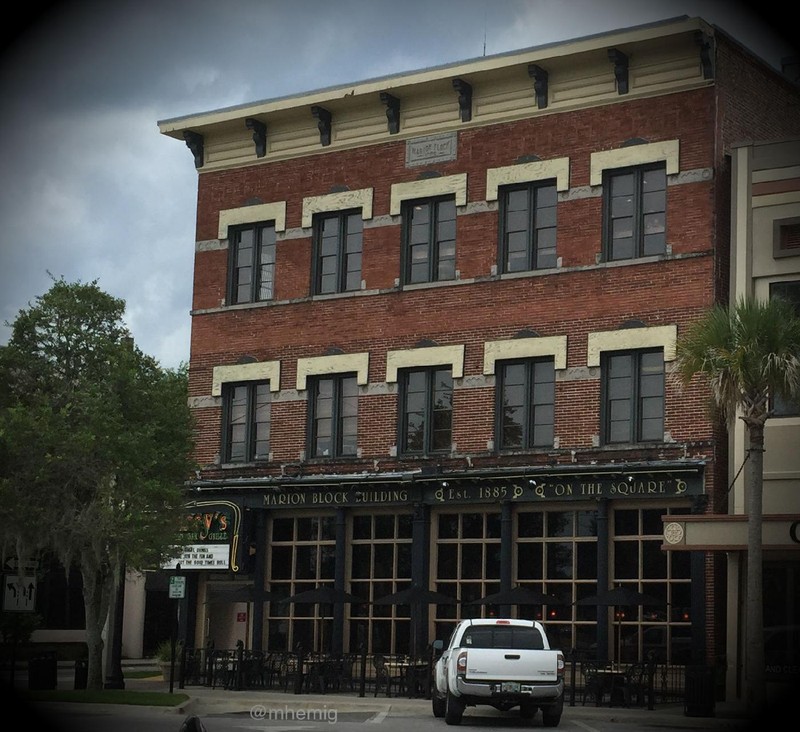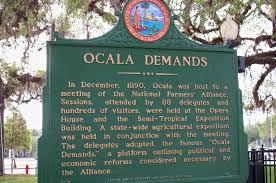Marion Opera House and the National Farmers' Alliance Ocala Demands of 1890
Introduction
Text-to-speech Audio
Images
Formerly known as the Marion Opera House, this building housed the meeting in which the "Ocala Demands" were made. This building is now know as the Marion Block House.

This placard, describing the meeting held in which the "Ocala Demands" were made, is situated outside of the Marion Block House as a historical marker.

Backstory and Context
Text-to-speech Audio
One of their biggest concerns was to eliminate the crop-lien system that developed in the United States. Farmers and sharecroppers who tended to crops, but did not own the land, were on a credit system for food and supplies from local merchants. These merchants placed a lien on the crops so that when harvested and sold, the merchants and land-owners were paid first, and the farmers were given what was left over. Due to the ever-changing price in cotton, it was not uncommon for farmers to not be paid at all by the end of the season.
The National Farmers' Alliance was also in support of government regulating the transportation industry, as railroad owners placed ridiculously high tax on the movement of goods throughout the country. While the development of the railroads was a benefit to farmers, the outrageous price of transporting goods often left farmers in debt and unable to provide the goods being demanded. Along with these desires, the National Farmers' Alliance supported reforms in both currency and income tax policies.
Another demand made by the Alliance was known as the "Sub-Treasury Plan" in which a system of warehouses, funded by the government, would be established in order for participating farmers to have access to the materials they needed at a low cost. Part of this plan involved farmers' being able to take out low-interest loans and pay back the government with U.S. Treasury notes. When the Democratic party refused to endorse this demand, the National Farmers' Alliance created their own political party, known as the People's Party.
In December 1890, the National Farmers’ Alliance gathered at the Marion Opera House in Ocala, Florida. Originally to be held in Jacksonville, the costly meeting was attended by 88 delegates and over 100 guests. Robert Rogers, president of the Alliance during the time, contacted John Dunn, president of a major bank in Ocala, and asked if he would be willing to host the meeting. Dunn agreed, contributed to the cost of the meeting, and landed Ocala on the map historically. During these meetings, a group of delegates, including John Rankin Rogers and Marion Butler (elected Populist officials), adopted the “Ocala Demands.” This set of political and economic reforms outlined the agenda for the People’s Party.
Although short lived, the "Populists" started a movement in rural areas, bringing awareness to the other parties and a voice to many poor farmers who had been struggling after the War. Eventually, the Democratic party adopted many of the beliefs of the People's Party and the organization ceased to exist as a national political party by the start of the 20th century.
Sources
Source 1
MLA: Proctor, Samuel. "The National Farmers' Alliance Convention of 1890
and Its "Ocala Demands"" The Florida Historical Quarterly28.3
(1950): 161-81. Web. 3 Oct. 2016.
APA: Proctor, S. (1950). The National Farmers' Alliance Convention of 1890 and
Its "Ocala Demands" The Florida Historical Quarterly,28(3), 161-181.
Retrieved October 3, 2016 from http://www.jstor.org/stable/30140577
This journal explores The National Farmers’ Alliance Convention of 1890 and the
“Ocala Demands,” which was the platform for political and economic reform that
was later adopted by the People’s Party. This information is pertinent to my
research because it will allow me to understand what changes were important and
necessary for farmers, and what steps it took them to present these issues in
the meetings that were held during the convention. This source is academic and
publishes peer-reviewed articles and historical notes and documents. Due to its
scholarly nature, this source is considered accurate and reliable.
Source 2
MLA: Hild, Matthew. "Farmers' Alliance." New Georgia Encyclopedia. 16
May 2016. Web. 03 October 2016.
APA: Hild, M. (2016, May 16). Farmers’ Alliance. Retrieved October 3, 2016,
from http://www.georgiaencyclopedia.org/articles/history-archaeology/farmers-alliance
This article explores how the Farmers’ Alliance was formed, their politics and
policies, and its eventual decline. The source is helpful to my research
because it provides a background and foundation for the events and setbacks and
led the way to the Convention of 1890, where the “Ocala Demands” were
proclaimed. Because the farmers’ concerns were both economic and political,
there are a lot of aspects to consider when understanding why certain changes
were necessary. This source is a reliable one, as it is maintained by the
Georgia Humanities Council, the University of Georgia Press, and the Office of
the Governor. The information is current and up to date.
Source 3
MLA: Edwards, Rebecca. "The Populist Party." 1896. N.p., 2000.
Web. 5 Nov. 2016.
APA: Edwards, R. (2000). The Populist Party. Retrieved November 5, 2016, from http://projects.vassar.edu/1896/populists.html
This collaboration of information includes the development, rise, and fall of
the Populist, or People’s Party. This source is helpful to my research
because the National Farmers’ Alliance grew into a major political party.
Their grievances weren’t petty, there was an entire community of politicians
who shared similar ideas for reform. By developing into a political
party, the Populists could campaign and inform others of their ideas, and how
their reforms could make life easier for everyone. I would say that this
source is a reliable one, as it was created and verified through Vassar College
for educational and teaching purposes, however because it was last updated in
2000, it is important to verify that all information is correct and up to
date.
Source 4
MLA: Stewart, James I. "The Economics of American Farm Unrest,
1865-1900." EH.net. N.p., 10 Feb. 2008. Web. 5 Nov. 2016.
APA: Stewart, J. I. (2008, February 10). The Economics of American Farm Unrest,
1865-1900. Retrieved November 5, 2016, from https://eh.net/encyclopedia/the-economics-of-american-farm-unrest-1865-1900/
This article describes how the economic changes in the United States after the
War played a role in farm unrest. Although there is debate regarding the
cause of unrest, it is generally agreed that “agrarian unrest reflected the
growing risks and uncertainties of agriculture after the Civil War.”
After the war, agriculture because more industrialized, which called for more
machines and less personal labor. It also called for farmers to depend on
merchants for food, supplies, credit, and anything else needed to keep a crop
healthy enough for harvest to sell. This information is important to my
research because it is important to understand WHY the farmers’ felt the need
to form an alliance in the first place. This source is a credible one, it is
maintained by the Economic History Association, which was established in
1940. The goal of the EHA is to research and educate on every aspect of
Economic History. Although the article was written in 2008, the
information appears to be accurate and un-biased, therefore I would considerate
it reliable.
Source 5
MLA: Wallace, Henry C. “The Farmers and the Railroads.” Proceedings of the
Academy of Political Science in the City of New York, vol. 10, no. 1, 1922, pp.
63–76. www.jstor.org/stable/1172105.
APA: Wallace, H. (1922). The Farmers and the Railroads. Proceedings of the
Academy of Political Science in the City of New York, 10(1), 63-76. doi:1.
Retrieved from http://www.jstor.org/stable/1172105
This journal explores the relationship between farmers and railroads.
Although the development of railroads was a significant benefit to farmers, the
railroad companies placed high taxes to transport goods throughout the
country. This often left farmers indebted to merchants and other
creditors. Because of this monopoly and unfair tax, farmers supported
government-regulated transportation and railroad communication. The
bottom line is that agriculture was dependent on railroads and it was important
to have a fair system in place. This information is beneficial to my
research because it is important to understand how even a great development
like the railroad system can cause unrest to those who need it most, and how
hard the Farmers’ Alliance fought for fair treatment from the railroad
companies. This source is academic, although publication ceased in 1991.
Due to its scholarly nature, this source is considered accurate and
reliable.
